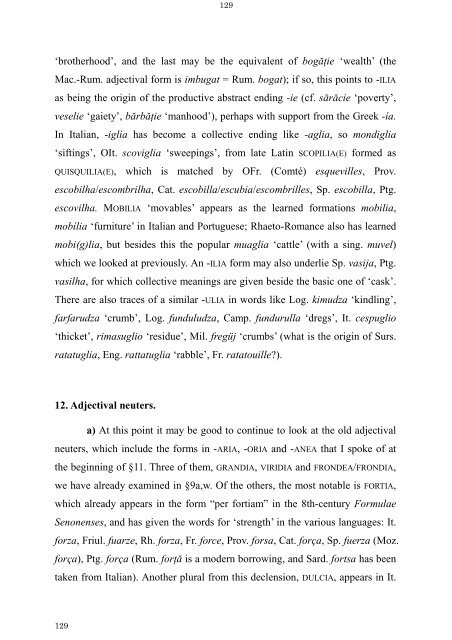The Latin Neuter Plurals in Romance - Page ON
The Latin Neuter Plurals in Romance - Page ON
The Latin Neuter Plurals in Romance - Page ON
Create successful ePaper yourself
Turn your PDF publications into a flip-book with our unique Google optimized e-Paper software.
129<br />
129<br />
‘brotherhood’, and the last may be the equivalent of bogăŃie ‘wealth’ (the<br />
Mac.-Rum. adjectival form is imbugat = Rum. bogat); if so, this po<strong>in</strong>ts to -ILIA<br />
as be<strong>in</strong>g the orig<strong>in</strong> of the productive abstract end<strong>in</strong>g -ie (cf. sărăcie ‘poverty’,<br />
veselie ‘gaiety’, bărbăŃie ‘manhood’), perhaps with support from the Greek -ía.<br />
In Italian, -iglia has become a collective end<strong>in</strong>g like -aglia, so mondiglia<br />
‘sift<strong>in</strong>gs’, OIt. scoviglia ‘sweep<strong>in</strong>gs’, from late <strong>Lat<strong>in</strong></strong> SCOPILIA(E) formed as<br />
QUISQUILIA(E), which is matched by OFr. (Comté) esquevilles, Prov.<br />
escobilha/escombrilha, Cat. escobilla/escubia/escombrilles, Sp. escobilla, Ptg.<br />
escovilha. MOBILIA ‘movables’ appears as the learned formations mobilia,<br />
mobília ‘furniture’ <strong>in</strong> Italian and Portuguese; Rhaeto-<strong>Romance</strong> also has learned<br />
mobi(g)lia, but besides this the popular muaglia ‘cattle’ (with a s<strong>in</strong>g. muvel)<br />
which we looked at previously. An -ILIA form may also underlie Sp. vasija, Ptg.<br />
vasilha, for which collective mean<strong>in</strong>gs are given beside the basic one of ‘cask’.<br />
<strong>The</strong>re are also traces of a similar -ULIA <strong>in</strong> words like Log. kimudza ‘k<strong>in</strong>dl<strong>in</strong>g’,<br />
farfarudza ‘crumb’, Log. funduludza, Camp. fundurulla ‘dregs’, It. cespuglio<br />
‘thicket’, rimasuglio ‘residue’, Mil. fregüj ‘crumbs’ (what is the orig<strong>in</strong> of Surs.<br />
ratatuglia, Eng. rattatuglia ‘rabble’, Fr. ratatouille?).<br />
12. Adjectival neuters.<br />
a) At this po<strong>in</strong>t it may be good to cont<strong>in</strong>ue to look at the old adjectival<br />
neuters, which <strong>in</strong>clude the forms <strong>in</strong> -ARIA, -ORIA and -ANEA that I spoke of at<br />
the beg<strong>in</strong>n<strong>in</strong>g of §11. Three of them, GRANDIA, VIRIDIA and FR<strong>ON</strong>DEA/FR<strong>ON</strong>DIA,<br />
we have already exam<strong>in</strong>ed <strong>in</strong> §9a,w. Of the others, the most notable is FORTIA,<br />
which already appears <strong>in</strong> the form “per fortiam” <strong>in</strong> the 8th-century Formulae<br />
Senonenses, and has given the words for ‘strength’ <strong>in</strong> the various languages: It.<br />
forza, Friul. fuarze, Rh. forza, Fr. force, Prov. forsa, Cat. força, Sp. fuerza (Moz.<br />
força), Ptg. força (Rum. forŃă is a modern borrow<strong>in</strong>g, and Sard. fortsa has been<br />
taken from Italian). Another plural from this declension, DULCIA, appears <strong>in</strong> It.









